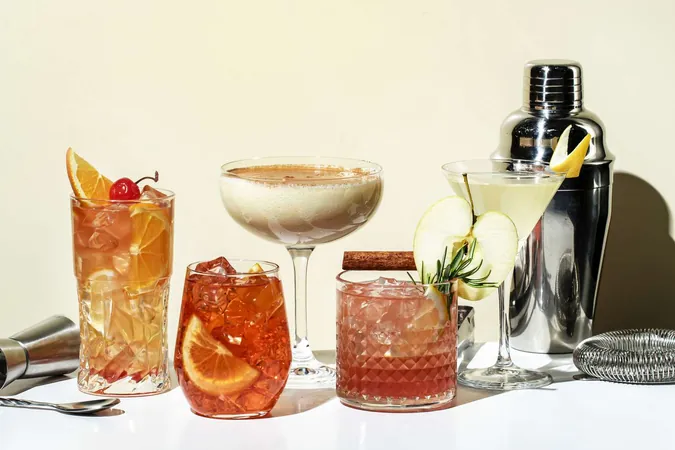
The Truth About Drinking in Moderation: What Experts Want You to Know
2025-01-04
Author: Arjun
As the festive holiday season approaches, gatherings filled with nostalgic movies, festive lights, and delectable homemade treats lead many to celebrate with abundant alcoholic beverages. However, as the festivities wind down and the winter days grow shorter, the urge to indulge in that leftover bottle of wine often resurfaces. Health professionals continue to voice one resounding piece of advice: "Drink in moderation." But what does this term truly entail? Is it a universal definition or a flexible guideline? Let's delve into what drinking in moderation means, backed by the latest research and expert recommendations.
The Health Risks of Alcohol Consumption
Although a glass of wine has often been touted as a heart-healthy choice, experts caution against overindulgence. Excessive alcohol consumption can result in a myriad of health issues both in the immediate and distant future, from inflammation leading to chronic diseases like liver issues and heart complications to a heightened risk for various forms of cancer.
Moreover, alcohol's inflammation is particularly detrimental to gut health, where it can disrupt the delicate balance of the gut microbiome—an essential component of immune and digestive health. The ripple effects of poor gut health can impact mental health, sleep patterns, and cognitive function, reinforcing the call for moderation in consumption.
Defining ‘Drinking in Moderation’
The definition of moderate drinking can vary, but national guidelines provide a structured starting point. According to the 2020-2025 Dietary Guidelines for Americans, moderate drinking is characterized as up to one drink per day for women and up to two drinks per day for men.
So, what constitutes "one drink"? The National Institute of Alcohol Abuse and Alcoholism specifies that a standard drink contains about 14 grams of pure alcohol, which translates to: - 12 ounces of beer (around 5% alcohol) - 5 ounces of wine (about 12% alcohol) - 1.5 ounces of distilled spirits (approximately 40% alcohol) In contrast, the World Health Organization has issued alarming statements suggesting that no amount of alcohol is truly safe, urging a reevaluation of consumption habits.
Trends in Alcohol Recommendations
This narrative is evolving rapidly. Research continues to emerge showing that even low to moderate alcohol consumption may lack health benefits and could even be detrimental. The U.S. Surgeon General recently highlighted that alcohol is the third leading preventable cause of cancer in the United States, linking it to at least seven cancer types.
Nutritionists are also adjusting their views, often recommending a more conservative consumption rate of around two to four drinks per week as a healthier target.
Binge Drinking: A Dangerous Crossroad
Distinguishing moderate drinking from binge drinking is crucial. Binge drinking is clinically defined as consuming enough alcohol to elevate blood alcohol concentration (BAC) to 0.08 g/dL or more, typically achieved by four drinks in two hours for women and five for men. This pattern is linked to severe health risks, including injuries, alcohol poisoning, and aggressive behavior.
Tips for Mindful Drinking
If you're seeking to enjoy alcoholic beverages while prioritizing health, consider these practical strategies to reduce your intake and implement moderation: 1. **Dilution**: Mix your drinks with sparkling water or juice to reduce the overall alcohol content while still savoring the flavor. 2. **Alternate Drinks**: Embrace the "one for one" rule by drinking water or non-alcoholic beverages between alcoholic ones. 3. **Communicate**: Being open with friends and family about your desire to drink less can create a supportive atmosphere for healthier choices. 4. **Change the Focus**: Organize social gatherings around activities that don’t involve drinking, such as game nights or nature walks. 5. **Set Goals**: Write down specific, attainable aims for your drinking habits, whether it’s limiting the number of drinks per week or opting for alcohol-free days. 6. **Explore Alternatives**: The market for non-alcoholic beverages has exploded, offering delicious and creative options that provide great tasting experiences without the alcohol. 7. **Healthier Choices**: When you do drink, choose options that are lower in added sugars, like pure fruit juices or seltzers, and consider beverages that offer additional health benefits.
In sum, moderation is key when it comes to alcohol consumption. With evolving research and substantial guidelines, creating a balanced approach to drinking during both festive seasons and everyday life can help enhance overall wellbeing. Cheers to healthier choices!
 Brasil (PT)
Brasil (PT)
 Canada (EN)
Canada (EN)
 Chile (ES)
Chile (ES)
 Česko (CS)
Česko (CS)
 대한민국 (KO)
대한민국 (KO)
 España (ES)
España (ES)
 France (FR)
France (FR)
 Hong Kong (EN)
Hong Kong (EN)
 Italia (IT)
Italia (IT)
 日本 (JA)
日本 (JA)
 Magyarország (HU)
Magyarország (HU)
 Norge (NO)
Norge (NO)
 Polska (PL)
Polska (PL)
 Schweiz (DE)
Schweiz (DE)
 Singapore (EN)
Singapore (EN)
 Sverige (SV)
Sverige (SV)
 Suomi (FI)
Suomi (FI)
 Türkiye (TR)
Türkiye (TR)
 الإمارات العربية المتحدة (AR)
الإمارات العربية المتحدة (AR)